Multinational Companies and Business Environment in India: A Study
VerifiedAdded on 2020/10/22
|21
|4969
|441
Project
AI Summary
This project examines the impact of multinational companies (MNCs) on the business environment of India, focusing on globalization, challenges faced by local businesses, and potential opportunities. The project includes a project management plan, work breakdown structure, and Gantt chart to outline the research process. It utilizes an interpretivism research philosophy and inductive research approach. The research design is explanatory, employing random sampling of HR managers. Data collection involves primary and secondary data, analyzed using both qualitative and quantitative methods. The study aims to determine the impact of MNCs, particularly McDonald's, on the Indian economy, and provides recommendations to overcome negative impacts and capitalize on opportunities. The project covers key aspects of research methodology, data analysis, and interpretation, leading to conclusions and recommendations regarding the influence of MNCs on India's business landscape.

MANAGING A
SUCCESSFUL BUSINESS
PROJECT
SUCCESSFUL BUSINESS
PROJECT
Paraphrase This Document
Need a fresh take? Get an instant paraphrase of this document with our AI Paraphraser
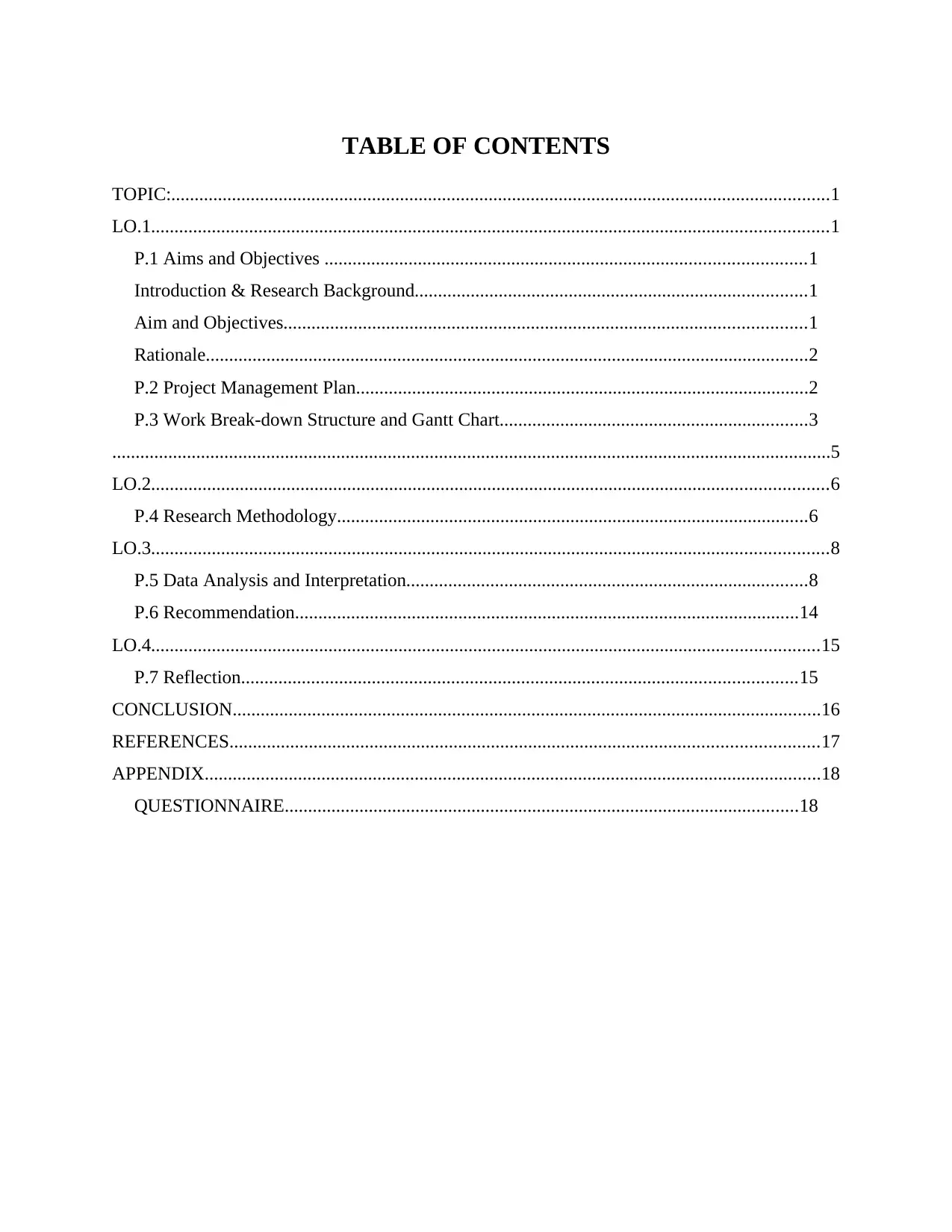
TABLE OF CONTENTS
TOPIC:.............................................................................................................................................1
LO.1.................................................................................................................................................1
P.1 Aims and Objectives .......................................................................................................1
Introduction & Research Background....................................................................................1
Aim and Objectives................................................................................................................1
Rationale.................................................................................................................................2
P.2 Project Management Plan.................................................................................................2
P.3 Work Break-down Structure and Gantt Chart..................................................................3
..........................................................................................................................................................5
LO.2.................................................................................................................................................6
P.4 Research Methodology.....................................................................................................6
LO.3.................................................................................................................................................8
P.5 Data Analysis and Interpretation......................................................................................8
P.6 Recommendation............................................................................................................14
LO.4...............................................................................................................................................15
P.7 Reflection.......................................................................................................................15
CONCLUSION..............................................................................................................................16
REFERENCES..............................................................................................................................17
APPENDIX....................................................................................................................................18
QUESTIONNAIRE..............................................................................................................18
TOPIC:.............................................................................................................................................1
LO.1.................................................................................................................................................1
P.1 Aims and Objectives .......................................................................................................1
Introduction & Research Background....................................................................................1
Aim and Objectives................................................................................................................1
Rationale.................................................................................................................................2
P.2 Project Management Plan.................................................................................................2
P.3 Work Break-down Structure and Gantt Chart..................................................................3
..........................................................................................................................................................5
LO.2.................................................................................................................................................6
P.4 Research Methodology.....................................................................................................6
LO.3.................................................................................................................................................8
P.5 Data Analysis and Interpretation......................................................................................8
P.6 Recommendation............................................................................................................14
LO.4...............................................................................................................................................15
P.7 Reflection.......................................................................................................................15
CONCLUSION..............................................................................................................................16
REFERENCES..............................................................................................................................17
APPENDIX....................................................................................................................................18
QUESTIONNAIRE..............................................................................................................18
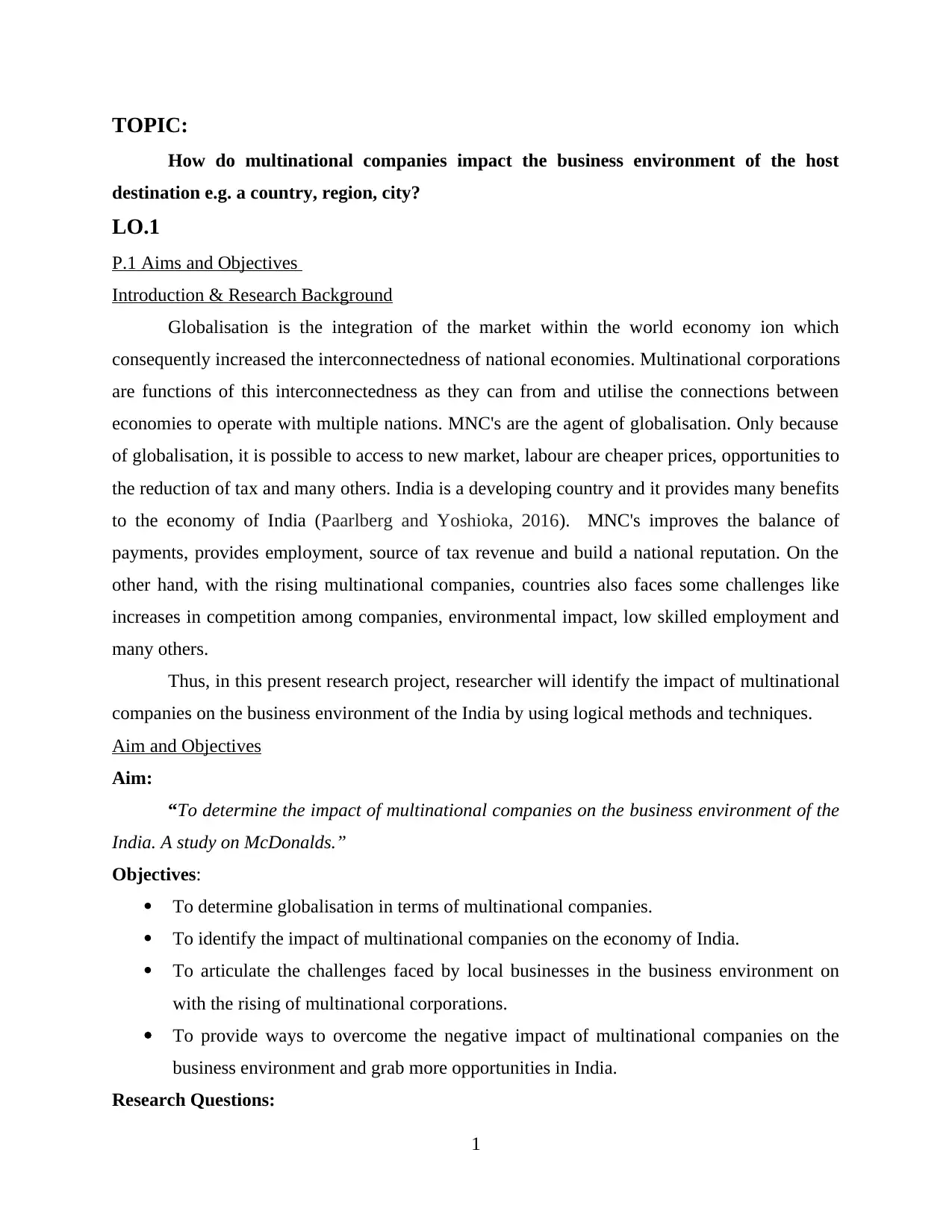
TOPIC:
How do multinational companies impact the business environment of the host
destination e.g. a country, region, city?
LO.1
P.1 Aims and Objectives
Introduction & Research Background
Globalisation is the integration of the market within the world economy ion which
consequently increased the interconnectedness of national economies. Multinational corporations
are functions of this interconnectedness as they can from and utilise the connections between
economies to operate with multiple nations. MNC's are the agent of globalisation. Only because
of globalisation, it is possible to access to new market, labour are cheaper prices, opportunities to
the reduction of tax and many others. India is a developing country and it provides many benefits
to the economy of India (Paarlberg and Yoshioka, 2016). MNC's improves the balance of
payments, provides employment, source of tax revenue and build a national reputation. On the
other hand, with the rising multinational companies, countries also faces some challenges like
increases in competition among companies, environmental impact, low skilled employment and
many others.
Thus, in this present research project, researcher will identify the impact of multinational
companies on the business environment of the India by using logical methods and techniques.
Aim and Objectives
Aim:
“To determine the impact of multinational companies on the business environment of the
India. A study on McDonalds.”
Objectives:
To determine globalisation in terms of multinational companies.
To identify the impact of multinational companies on the economy of India.
To articulate the challenges faced by local businesses in the business environment on
with the rising of multinational corporations.
To provide ways to overcome the negative impact of multinational companies on the
business environment and grab more opportunities in India.
Research Questions:
1
How do multinational companies impact the business environment of the host
destination e.g. a country, region, city?
LO.1
P.1 Aims and Objectives
Introduction & Research Background
Globalisation is the integration of the market within the world economy ion which
consequently increased the interconnectedness of national economies. Multinational corporations
are functions of this interconnectedness as they can from and utilise the connections between
economies to operate with multiple nations. MNC's are the agent of globalisation. Only because
of globalisation, it is possible to access to new market, labour are cheaper prices, opportunities to
the reduction of tax and many others. India is a developing country and it provides many benefits
to the economy of India (Paarlberg and Yoshioka, 2016). MNC's improves the balance of
payments, provides employment, source of tax revenue and build a national reputation. On the
other hand, with the rising multinational companies, countries also faces some challenges like
increases in competition among companies, environmental impact, low skilled employment and
many others.
Thus, in this present research project, researcher will identify the impact of multinational
companies on the business environment of the India by using logical methods and techniques.
Aim and Objectives
Aim:
“To determine the impact of multinational companies on the business environment of the
India. A study on McDonalds.”
Objectives:
To determine globalisation in terms of multinational companies.
To identify the impact of multinational companies on the economy of India.
To articulate the challenges faced by local businesses in the business environment on
with the rising of multinational corporations.
To provide ways to overcome the negative impact of multinational companies on the
business environment and grab more opportunities in India.
Research Questions:
1
⊘ This is a preview!⊘
Do you want full access?
Subscribe today to unlock all pages.

Trusted by 1+ million students worldwide
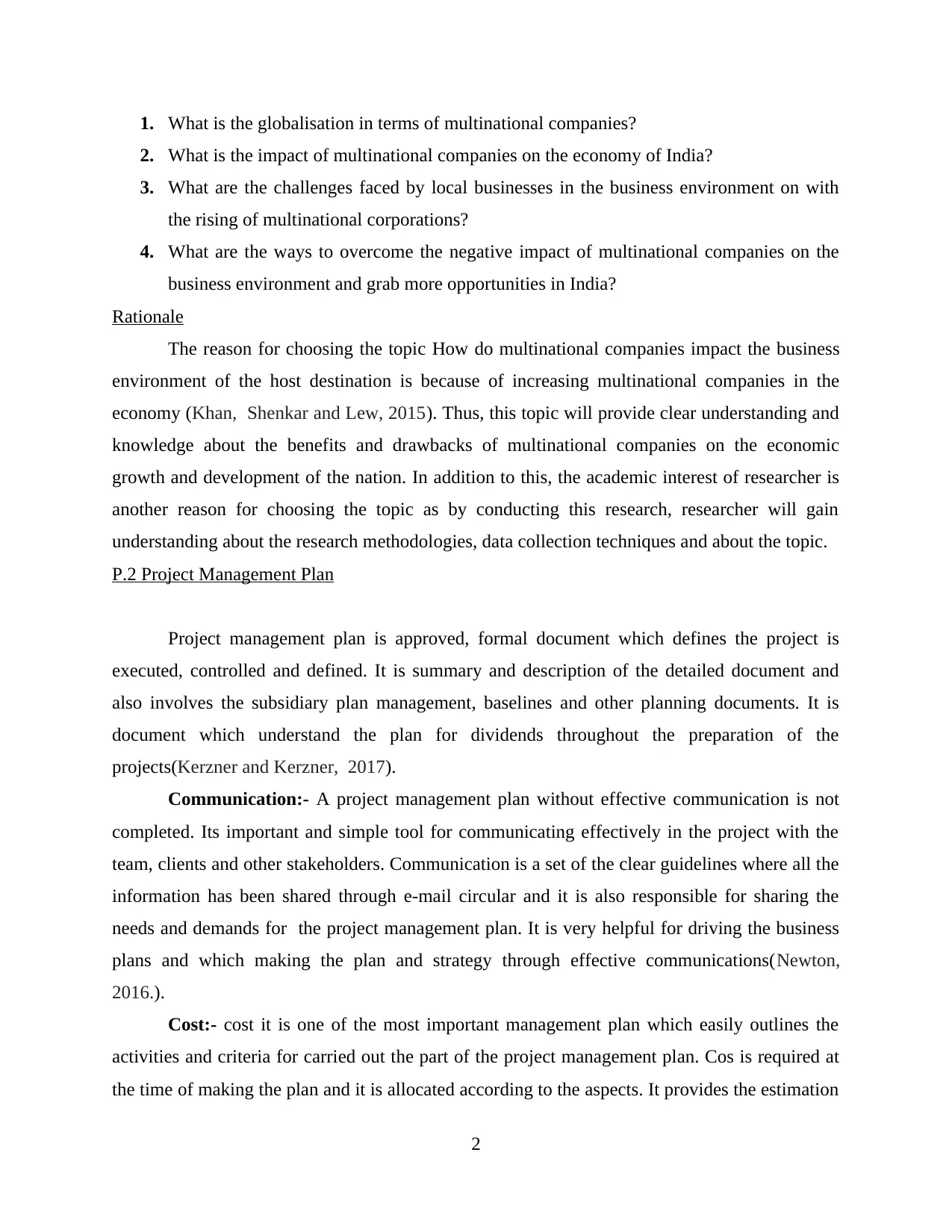
1. What is the globalisation in terms of multinational companies?
2. What is the impact of multinational companies on the economy of India?
3. What are the challenges faced by local businesses in the business environment on with
the rising of multinational corporations?
4. What are the ways to overcome the negative impact of multinational companies on the
business environment and grab more opportunities in India?
Rationale
The reason for choosing the topic How do multinational companies impact the business
environment of the host destination is because of increasing multinational companies in the
economy (Khan, Shenkar and Lew, 2015). Thus, this topic will provide clear understanding and
knowledge about the benefits and drawbacks of multinational companies on the economic
growth and development of the nation. In addition to this, the academic interest of researcher is
another reason for choosing the topic as by conducting this research, researcher will gain
understanding about the research methodologies, data collection techniques and about the topic.
P.2 Project Management Plan
Project management plan is approved, formal document which defines the project is
executed, controlled and defined. It is summary and description of the detailed document and
also involves the subsidiary plan management, baselines and other planning documents. It is
document which understand the plan for dividends throughout the preparation of the
projects(Kerzner and Kerzner, 2017).
Communication:- A project management plan without effective communication is not
completed. Its important and simple tool for communicating effectively in the project with the
team, clients and other stakeholders. Communication is a set of the clear guidelines where all the
information has been shared through e-mail circular and it is also responsible for sharing the
needs and demands for the project management plan. It is very helpful for driving the business
plans and which making the plan and strategy through effective communications(Newton,
2016.).
Cost:- cost it is one of the most important management plan which easily outlines the
activities and criteria for carried out the part of the project management plan. Cos is required at
the time of making the plan and it is allocated according to the aspects. It provides the estimation
2
2. What is the impact of multinational companies on the economy of India?
3. What are the challenges faced by local businesses in the business environment on with
the rising of multinational corporations?
4. What are the ways to overcome the negative impact of multinational companies on the
business environment and grab more opportunities in India?
Rationale
The reason for choosing the topic How do multinational companies impact the business
environment of the host destination is because of increasing multinational companies in the
economy (Khan, Shenkar and Lew, 2015). Thus, this topic will provide clear understanding and
knowledge about the benefits and drawbacks of multinational companies on the economic
growth and development of the nation. In addition to this, the academic interest of researcher is
another reason for choosing the topic as by conducting this research, researcher will gain
understanding about the research methodologies, data collection techniques and about the topic.
P.2 Project Management Plan
Project management plan is approved, formal document which defines the project is
executed, controlled and defined. It is summary and description of the detailed document and
also involves the subsidiary plan management, baselines and other planning documents. It is
document which understand the plan for dividends throughout the preparation of the
projects(Kerzner and Kerzner, 2017).
Communication:- A project management plan without effective communication is not
completed. Its important and simple tool for communicating effectively in the project with the
team, clients and other stakeholders. Communication is a set of the clear guidelines where all the
information has been shared through e-mail circular and it is also responsible for sharing the
needs and demands for the project management plan. It is very helpful for driving the business
plans and which making the plan and strategy through effective communications(Newton,
2016.).
Cost:- cost it is one of the most important management plan which easily outlines the
activities and criteria for carried out the part of the project management plan. Cos is required at
the time of making the plan and it is allocated according to the aspects. It provides the estimation
2
Paraphrase This Document
Need a fresh take? Get an instant paraphrase of this document with our AI Paraphraser
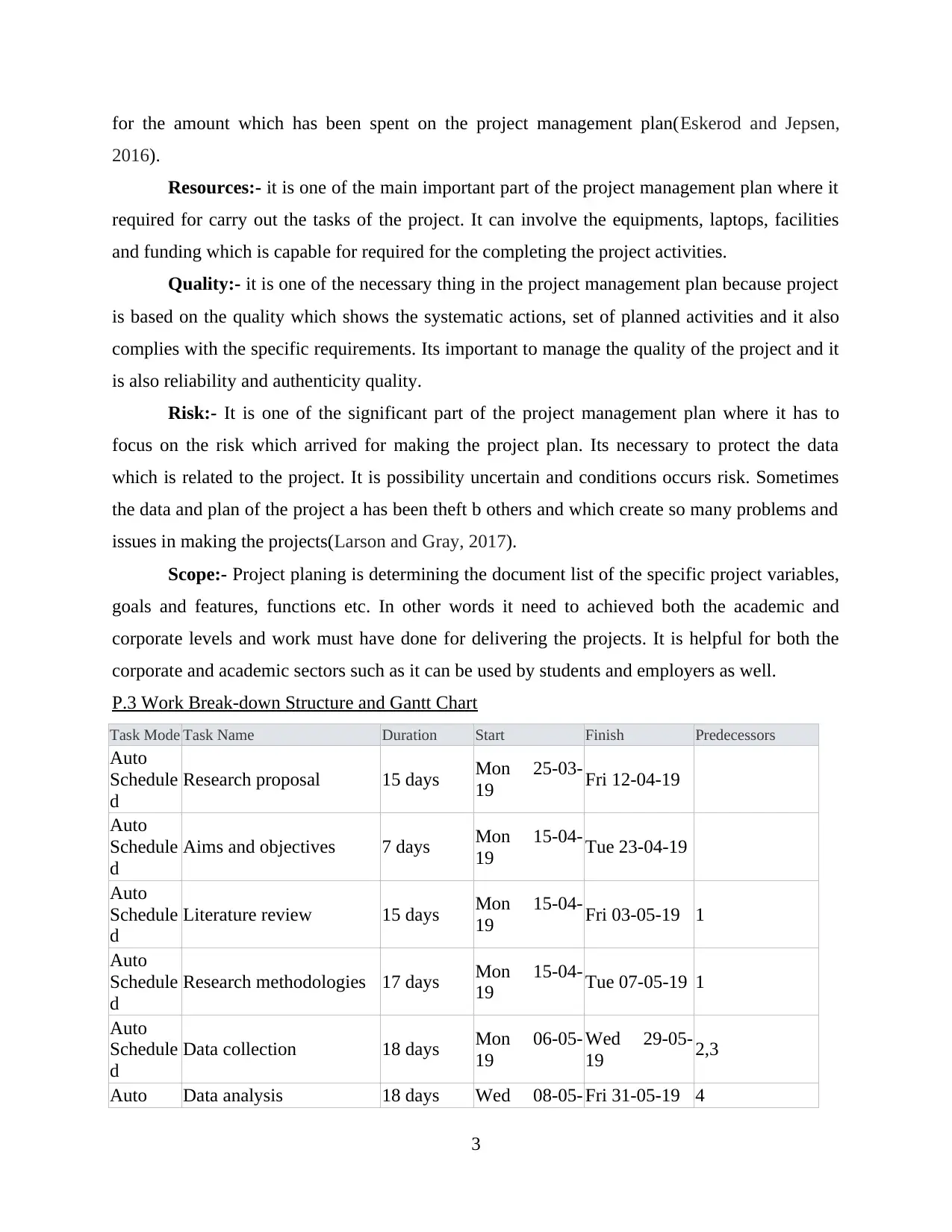
for the amount which has been spent on the project management plan(Eskerod and Jepsen,
2016).
Resources:- it is one of the main important part of the project management plan where it
required for carry out the tasks of the project. It can involve the equipments, laptops, facilities
and funding which is capable for required for the completing the project activities.
Quality:- it is one of the necessary thing in the project management plan because project
is based on the quality which shows the systematic actions, set of planned activities and it also
complies with the specific requirements. Its important to manage the quality of the project and it
is also reliability and authenticity quality.
Risk:- It is one of the significant part of the project management plan where it has to
focus on the risk which arrived for making the project plan. Its necessary to protect the data
which is related to the project. It is possibility uncertain and conditions occurs risk. Sometimes
the data and plan of the project a has been theft b others and which create so many problems and
issues in making the projects(Larson and Gray, 2017).
Scope:- Project planing is determining the document list of the specific project variables,
goals and features, functions etc. In other words it need to achieved both the academic and
corporate levels and work must have done for delivering the projects. It is helpful for both the
corporate and academic sectors such as it can be used by students and employers as well.
P.3 Work Break-down Structure and Gantt Chart
Task Mode Task Name Duration Start Finish Predecessors
Auto
Schedule
d
Research proposal 15 days Mon 25-03-
19 Fri 12-04-19
Auto
Schedule
d
Aims and objectives 7 days Mon 15-04-
19 Tue 23-04-19
Auto
Schedule
d
Literature review 15 days Mon 15-04-
19 Fri 03-05-19 1
Auto
Schedule
d
Research methodologies 17 days Mon 15-04-
19 Tue 07-05-19 1
Auto
Schedule
d
Data collection 18 days Mon 06-05-
19
Wed 29-05-
19 2,3
Auto Data analysis 18 days Wed 08-05- Fri 31-05-19 4
3
2016).
Resources:- it is one of the main important part of the project management plan where it
required for carry out the tasks of the project. It can involve the equipments, laptops, facilities
and funding which is capable for required for the completing the project activities.
Quality:- it is one of the necessary thing in the project management plan because project
is based on the quality which shows the systematic actions, set of planned activities and it also
complies with the specific requirements. Its important to manage the quality of the project and it
is also reliability and authenticity quality.
Risk:- It is one of the significant part of the project management plan where it has to
focus on the risk which arrived for making the project plan. Its necessary to protect the data
which is related to the project. It is possibility uncertain and conditions occurs risk. Sometimes
the data and plan of the project a has been theft b others and which create so many problems and
issues in making the projects(Larson and Gray, 2017).
Scope:- Project planing is determining the document list of the specific project variables,
goals and features, functions etc. In other words it need to achieved both the academic and
corporate levels and work must have done for delivering the projects. It is helpful for both the
corporate and academic sectors such as it can be used by students and employers as well.
P.3 Work Break-down Structure and Gantt Chart
Task Mode Task Name Duration Start Finish Predecessors
Auto
Schedule
d
Research proposal 15 days Mon 25-03-
19 Fri 12-04-19
Auto
Schedule
d
Aims and objectives 7 days Mon 15-04-
19 Tue 23-04-19
Auto
Schedule
d
Literature review 15 days Mon 15-04-
19 Fri 03-05-19 1
Auto
Schedule
d
Research methodologies 17 days Mon 15-04-
19 Tue 07-05-19 1
Auto
Schedule
d
Data collection 18 days Mon 06-05-
19
Wed 29-05-
19 2,3
Auto Data analysis 18 days Wed 08-05- Fri 31-05-19 4
3
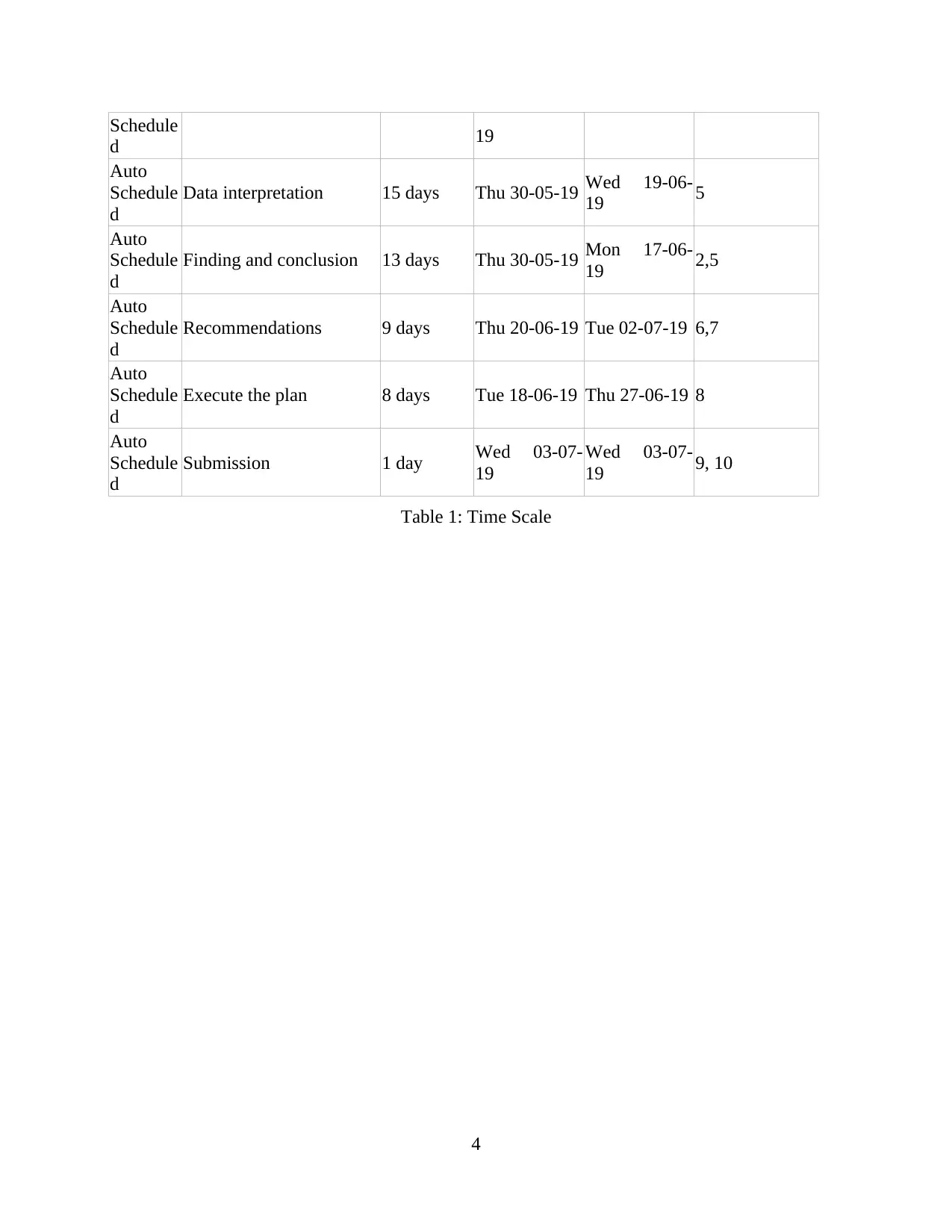
Schedule
d 19
Auto
Schedule
d
Data interpretation 15 days Thu 30-05-19 Wed 19-06-
19 5
Auto
Schedule
d
Finding and conclusion 13 days Thu 30-05-19 Mon 17-06-
19 2,5
Auto
Schedule
d
Recommendations 9 days Thu 20-06-19 Tue 02-07-19 6,7
Auto
Schedule
d
Execute the plan 8 days Tue 18-06-19 Thu 27-06-19 8
Auto
Schedule
d
Submission 1 day Wed 03-07-
19
Wed 03-07-
19 9, 10
Table 1: Time Scale
4
d 19
Auto
Schedule
d
Data interpretation 15 days Thu 30-05-19 Wed 19-06-
19 5
Auto
Schedule
d
Finding and conclusion 13 days Thu 30-05-19 Mon 17-06-
19 2,5
Auto
Schedule
d
Recommendations 9 days Thu 20-06-19 Tue 02-07-19 6,7
Auto
Schedule
d
Execute the plan 8 days Tue 18-06-19 Thu 27-06-19 8
Auto
Schedule
d
Submission 1 day Wed 03-07-
19
Wed 03-07-
19 9, 10
Table 1: Time Scale
4
⊘ This is a preview!⊘
Do you want full access?
Subscribe today to unlock all pages.

Trusted by 1+ million students worldwide
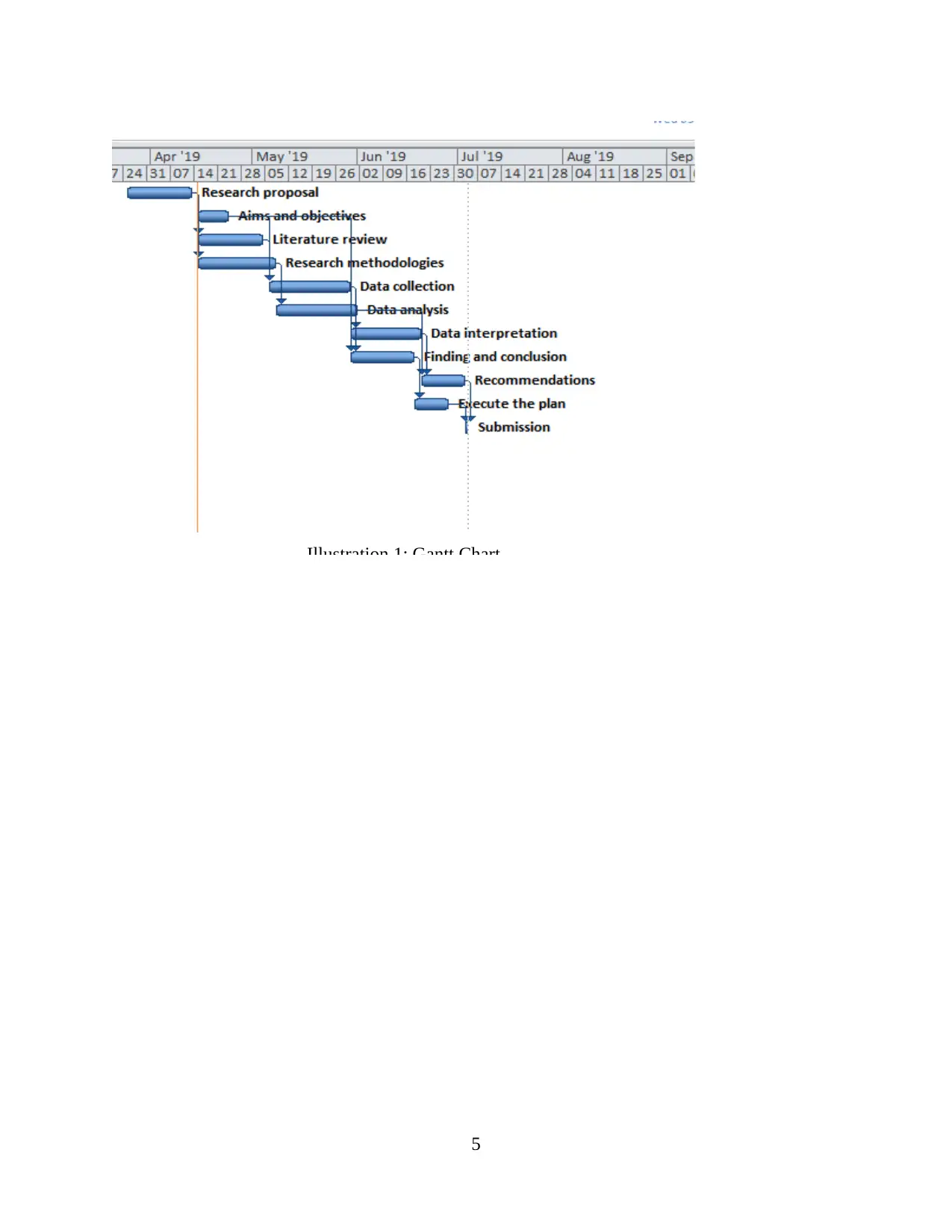
Illustration 1: Gantt Chart
5
5
Paraphrase This Document
Need a fresh take? Get an instant paraphrase of this document with our AI Paraphraser
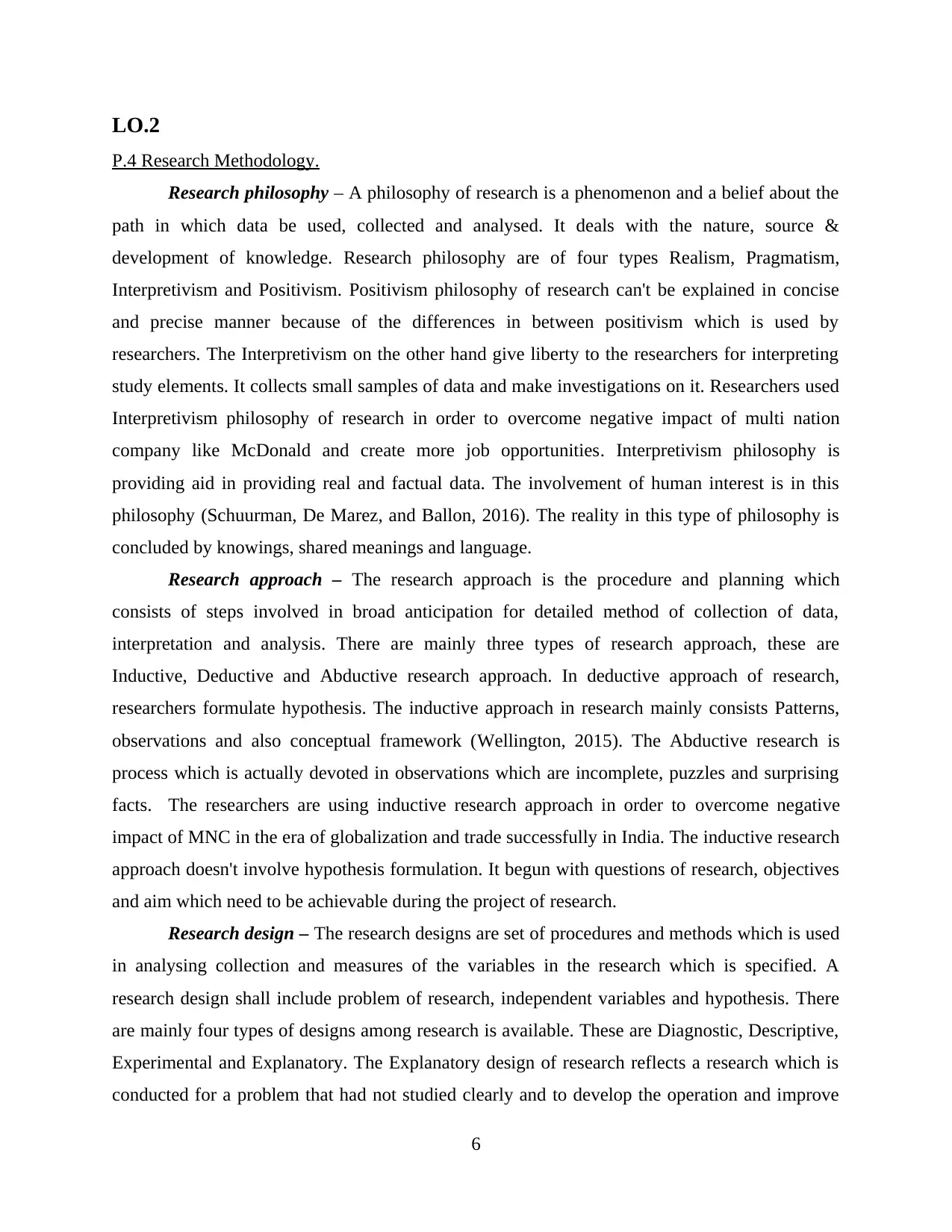
LO.2
P.4 Research Methodology.
Research philosophy – A philosophy of research is a phenomenon and a belief about the
path in which data be used, collected and analysed. It deals with the nature, source &
development of knowledge. Research philosophy are of four types Realism, Pragmatism,
Interpretivism and Positivism. Positivism philosophy of research can't be explained in concise
and precise manner because of the differences in between positivism which is used by
researchers. The Interpretivism on the other hand give liberty to the researchers for interpreting
study elements. It collects small samples of data and make investigations on it. Researchers used
Interpretivism philosophy of research in order to overcome negative impact of multi nation
company like McDonald and create more job opportunities. Interpretivism philosophy is
providing aid in providing real and factual data. The involvement of human interest is in this
philosophy (Schuurman, De Marez, and Ballon, 2016). The reality in this type of philosophy is
concluded by knowings, shared meanings and language.
Research approach – The research approach is the procedure and planning which
consists of steps involved in broad anticipation for detailed method of collection of data,
interpretation and analysis. There are mainly three types of research approach, these are
Inductive, Deductive and Abductive research approach. In deductive approach of research,
researchers formulate hypothesis. The inductive approach in research mainly consists Patterns,
observations and also conceptual framework (Wellington, 2015). The Abductive research is
process which is actually devoted in observations which are incomplete, puzzles and surprising
facts. The researchers are using inductive research approach in order to overcome negative
impact of MNC in the era of globalization and trade successfully in India. The inductive research
approach doesn't involve hypothesis formulation. It begun with questions of research, objectives
and aim which need to be achievable during the project of research.
Research design – The research designs are set of procedures and methods which is used
in analysing collection and measures of the variables in the research which is specified. A
research design shall include problem of research, independent variables and hypothesis. There
are mainly four types of designs among research is available. These are Diagnostic, Descriptive,
Experimental and Explanatory. The Explanatory design of research reflects a research which is
conducted for a problem that had not studied clearly and to develop the operation and improve
6
P.4 Research Methodology.
Research philosophy – A philosophy of research is a phenomenon and a belief about the
path in which data be used, collected and analysed. It deals with the nature, source &
development of knowledge. Research philosophy are of four types Realism, Pragmatism,
Interpretivism and Positivism. Positivism philosophy of research can't be explained in concise
and precise manner because of the differences in between positivism which is used by
researchers. The Interpretivism on the other hand give liberty to the researchers for interpreting
study elements. It collects small samples of data and make investigations on it. Researchers used
Interpretivism philosophy of research in order to overcome negative impact of multi nation
company like McDonald and create more job opportunities. Interpretivism philosophy is
providing aid in providing real and factual data. The involvement of human interest is in this
philosophy (Schuurman, De Marez, and Ballon, 2016). The reality in this type of philosophy is
concluded by knowings, shared meanings and language.
Research approach – The research approach is the procedure and planning which
consists of steps involved in broad anticipation for detailed method of collection of data,
interpretation and analysis. There are mainly three types of research approach, these are
Inductive, Deductive and Abductive research approach. In deductive approach of research,
researchers formulate hypothesis. The inductive approach in research mainly consists Patterns,
observations and also conceptual framework (Wellington, 2015). The Abductive research is
process which is actually devoted in observations which are incomplete, puzzles and surprising
facts. The researchers are using inductive research approach in order to overcome negative
impact of MNC in the era of globalization and trade successfully in India. The inductive research
approach doesn't involve hypothesis formulation. It begun with questions of research, objectives
and aim which need to be achievable during the project of research.
Research design – The research designs are set of procedures and methods which is used
in analysing collection and measures of the variables in the research which is specified. A
research design shall include problem of research, independent variables and hypothesis. There
are mainly four types of designs among research is available. These are Diagnostic, Descriptive,
Experimental and Explanatory. The Explanatory design of research reflects a research which is
conducted for a problem that had not studied clearly and to develop the operation and improve
6
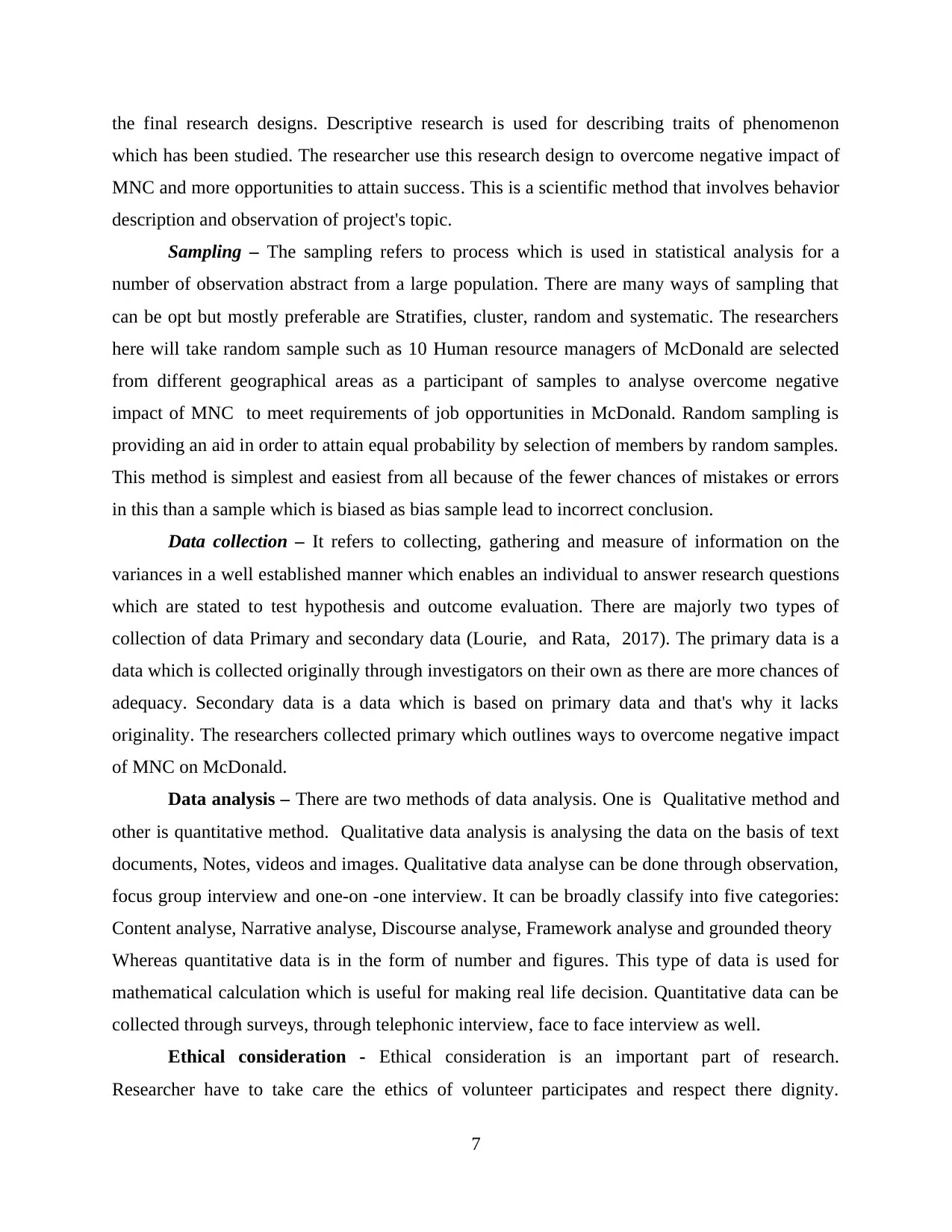
the final research designs. Descriptive research is used for describing traits of phenomenon
which has been studied. The researcher use this research design to overcome negative impact of
MNC and more opportunities to attain success. This is a scientific method that involves behavior
description and observation of project's topic.
Sampling – The sampling refers to process which is used in statistical analysis for a
number of observation abstract from a large population. There are many ways of sampling that
can be opt but mostly preferable are Stratifies, cluster, random and systematic. The researchers
here will take random sample such as 10 Human resource managers of McDonald are selected
from different geographical areas as a participant of samples to analyse overcome negative
impact of MNC to meet requirements of job opportunities in McDonald. Random sampling is
providing an aid in order to attain equal probability by selection of members by random samples.
This method is simplest and easiest from all because of the fewer chances of mistakes or errors
in this than a sample which is biased as bias sample lead to incorrect conclusion.
Data collection – It refers to collecting, gathering and measure of information on the
variances in a well established manner which enables an individual to answer research questions
which are stated to test hypothesis and outcome evaluation. There are majorly two types of
collection of data Primary and secondary data (Lourie, and Rata, 2017). The primary data is a
data which is collected originally through investigators on their own as there are more chances of
adequacy. Secondary data is a data which is based on primary data and that's why it lacks
originality. The researchers collected primary which outlines ways to overcome negative impact
of MNC on McDonald.
Data analysis – There are two methods of data analysis. One is Qualitative method and
other is quantitative method. Qualitative data analysis is analysing the data on the basis of text
documents, Notes, videos and images. Qualitative data analyse can be done through observation,
focus group interview and one-on -one interview. It can be broadly classify into five categories:
Content analyse, Narrative analyse, Discourse analyse, Framework analyse and grounded theory
Whereas quantitative data is in the form of number and figures. This type of data is used for
mathematical calculation which is useful for making real life decision. Quantitative data can be
collected through surveys, through telephonic interview, face to face interview as well.
Ethical consideration - Ethical consideration is an important part of research.
Researcher have to take care the ethics of volunteer participates and respect there dignity.
7
which has been studied. The researcher use this research design to overcome negative impact of
MNC and more opportunities to attain success. This is a scientific method that involves behavior
description and observation of project's topic.
Sampling – The sampling refers to process which is used in statistical analysis for a
number of observation abstract from a large population. There are many ways of sampling that
can be opt but mostly preferable are Stratifies, cluster, random and systematic. The researchers
here will take random sample such as 10 Human resource managers of McDonald are selected
from different geographical areas as a participant of samples to analyse overcome negative
impact of MNC to meet requirements of job opportunities in McDonald. Random sampling is
providing an aid in order to attain equal probability by selection of members by random samples.
This method is simplest and easiest from all because of the fewer chances of mistakes or errors
in this than a sample which is biased as bias sample lead to incorrect conclusion.
Data collection – It refers to collecting, gathering and measure of information on the
variances in a well established manner which enables an individual to answer research questions
which are stated to test hypothesis and outcome evaluation. There are majorly two types of
collection of data Primary and secondary data (Lourie, and Rata, 2017). The primary data is a
data which is collected originally through investigators on their own as there are more chances of
adequacy. Secondary data is a data which is based on primary data and that's why it lacks
originality. The researchers collected primary which outlines ways to overcome negative impact
of MNC on McDonald.
Data analysis – There are two methods of data analysis. One is Qualitative method and
other is quantitative method. Qualitative data analysis is analysing the data on the basis of text
documents, Notes, videos and images. Qualitative data analyse can be done through observation,
focus group interview and one-on -one interview. It can be broadly classify into five categories:
Content analyse, Narrative analyse, Discourse analyse, Framework analyse and grounded theory
Whereas quantitative data is in the form of number and figures. This type of data is used for
mathematical calculation which is useful for making real life decision. Quantitative data can be
collected through surveys, through telephonic interview, face to face interview as well.
Ethical consideration - Ethical consideration is an important part of research.
Researcher have to take care the ethics of volunteer participates and respect there dignity.
7
⊘ This is a preview!⊘
Do you want full access?
Subscribe today to unlock all pages.

Trusted by 1+ million students worldwide
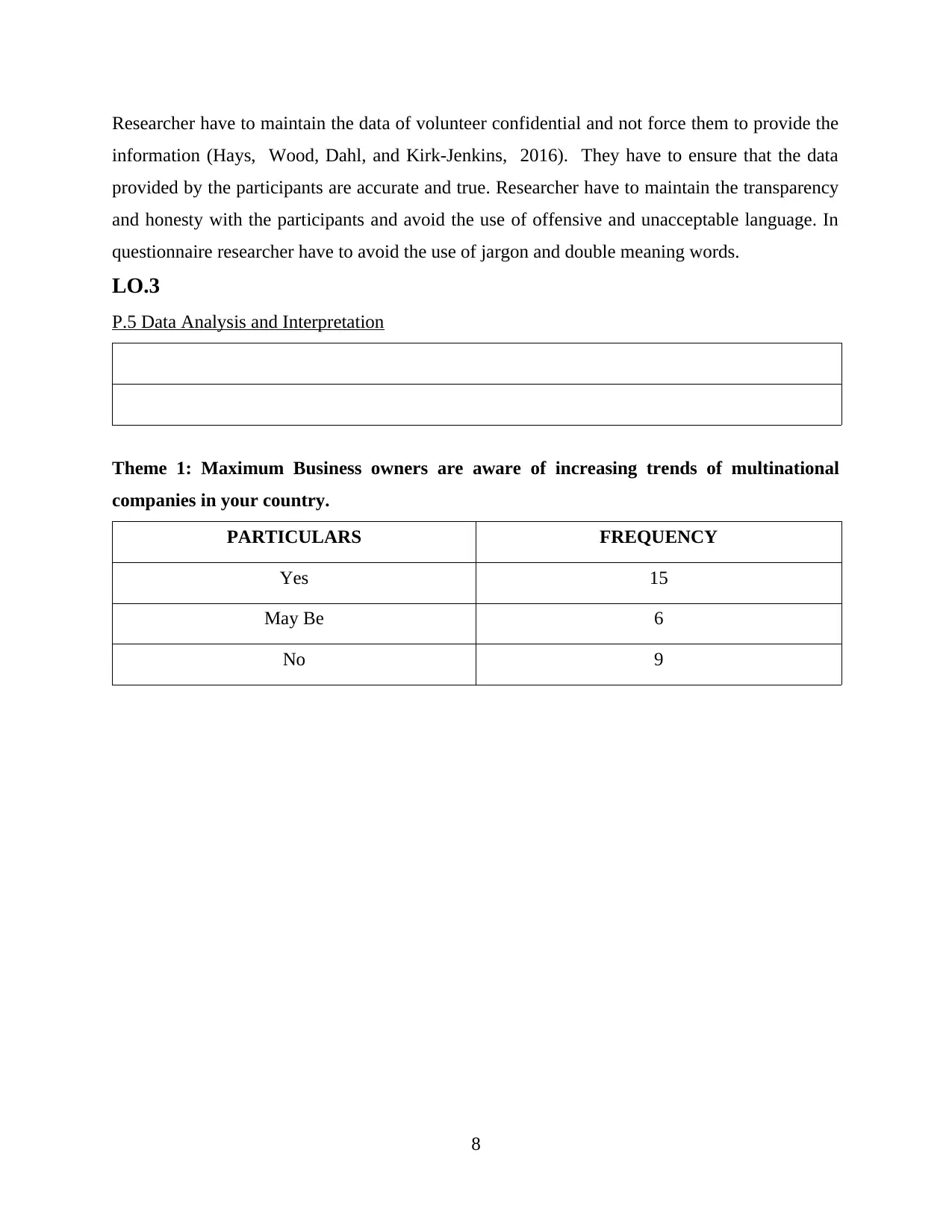
Researcher have to maintain the data of volunteer confidential and not force them to provide the
information (Hays, Wood, Dahl, and Kirk‐Jenkins, 2016). They have to ensure that the data
provided by the participants are accurate and true. Researcher have to maintain the transparency
and honesty with the participants and avoid the use of offensive and unacceptable language. In
questionnaire researcher have to avoid the use of jargon and double meaning words.
LO.3
P.5 Data Analysis and Interpretation
Theme 1: Maximum Business owners are aware of increasing trends of multinational
companies in your country.
PARTICULARS FREQUENCY
Yes 15
May Be 6
No 9
8
information (Hays, Wood, Dahl, and Kirk‐Jenkins, 2016). They have to ensure that the data
provided by the participants are accurate and true. Researcher have to maintain the transparency
and honesty with the participants and avoid the use of offensive and unacceptable language. In
questionnaire researcher have to avoid the use of jargon and double meaning words.
LO.3
P.5 Data Analysis and Interpretation
Theme 1: Maximum Business owners are aware of increasing trends of multinational
companies in your country.
PARTICULARS FREQUENCY
Yes 15
May Be 6
No 9
8
Paraphrase This Document
Need a fresh take? Get an instant paraphrase of this document with our AI Paraphraser
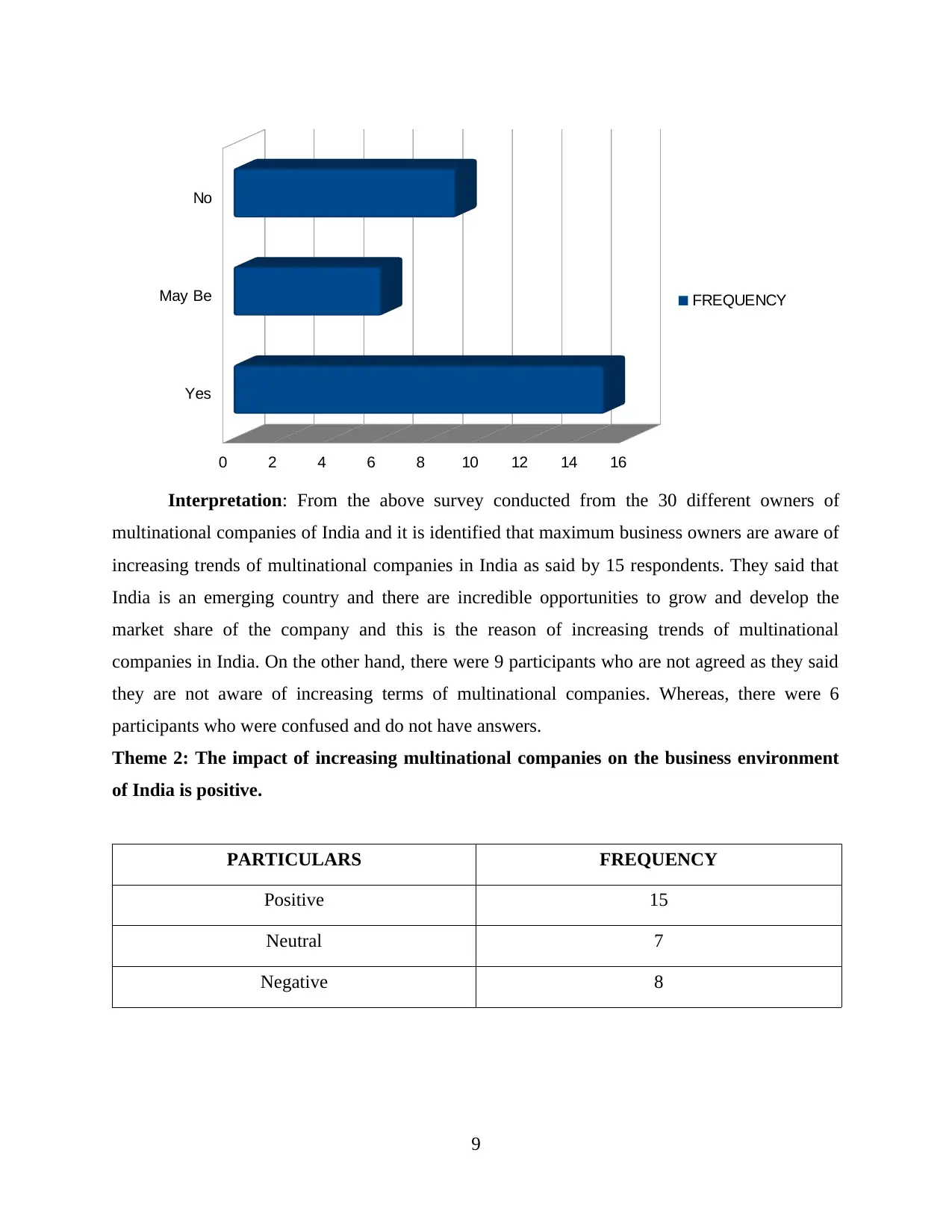
Interpretation: From the above survey conducted from the 30 different owners of
multinational companies of India and it is identified that maximum business owners are aware of
increasing trends of multinational companies in India as said by 15 respondents. They said that
India is an emerging country and there are incredible opportunities to grow and develop the
market share of the company and this is the reason of increasing trends of multinational
companies in India. On the other hand, there were 9 participants who are not agreed as they said
they are not aware of increasing terms of multinational companies. Whereas, there were 6
participants who were confused and do not have answers.
Theme 2: The impact of increasing multinational companies on the business environment
of India is positive.
PARTICULARS FREQUENCY
Positive 15
Neutral 7
Negative 8
9
Yes
May Be
No
0 2 4 6 8 10 12 14 16
FREQUENCY
multinational companies of India and it is identified that maximum business owners are aware of
increasing trends of multinational companies in India as said by 15 respondents. They said that
India is an emerging country and there are incredible opportunities to grow and develop the
market share of the company and this is the reason of increasing trends of multinational
companies in India. On the other hand, there were 9 participants who are not agreed as they said
they are not aware of increasing terms of multinational companies. Whereas, there were 6
participants who were confused and do not have answers.
Theme 2: The impact of increasing multinational companies on the business environment
of India is positive.
PARTICULARS FREQUENCY
Positive 15
Neutral 7
Negative 8
9
Yes
May Be
No
0 2 4 6 8 10 12 14 16
FREQUENCY
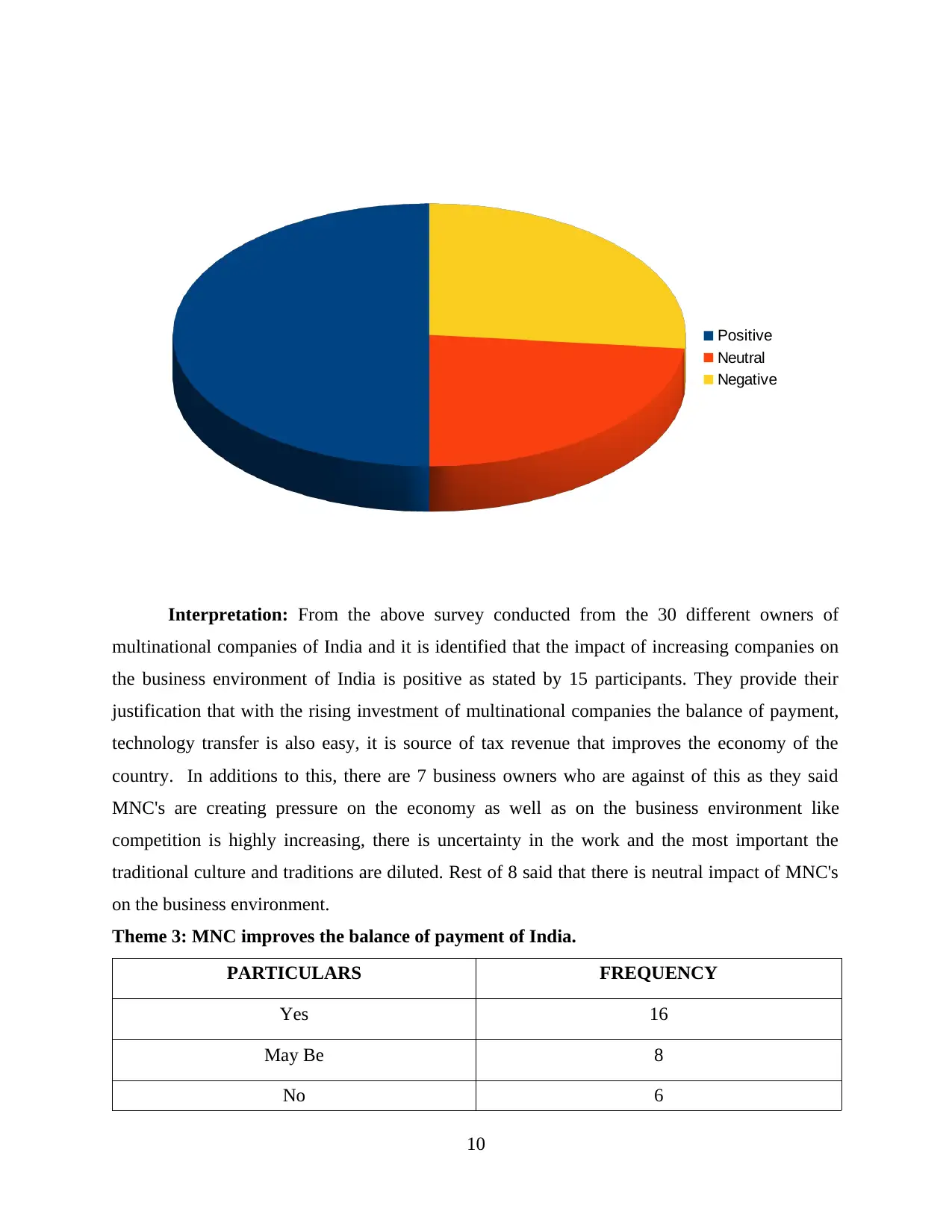
Interpretation: From the above survey conducted from the 30 different owners of
multinational companies of India and it is identified that the impact of increasing companies on
the business environment of India is positive as stated by 15 participants. They provide their
justification that with the rising investment of multinational companies the balance of payment,
technology transfer is also easy, it is source of tax revenue that improves the economy of the
country. In additions to this, there are 7 business owners who are against of this as they said
MNC's are creating pressure on the economy as well as on the business environment like
competition is highly increasing, there is uncertainty in the work and the most important the
traditional culture and traditions are diluted. Rest of 8 said that there is neutral impact of MNC's
on the business environment.
Theme 3: MNC improves the balance of payment of India.
PARTICULARS FREQUENCY
Yes 16
May Be 8
No 6
10
Positive
Neutral
Negative
multinational companies of India and it is identified that the impact of increasing companies on
the business environment of India is positive as stated by 15 participants. They provide their
justification that with the rising investment of multinational companies the balance of payment,
technology transfer is also easy, it is source of tax revenue that improves the economy of the
country. In additions to this, there are 7 business owners who are against of this as they said
MNC's are creating pressure on the economy as well as on the business environment like
competition is highly increasing, there is uncertainty in the work and the most important the
traditional culture and traditions are diluted. Rest of 8 said that there is neutral impact of MNC's
on the business environment.
Theme 3: MNC improves the balance of payment of India.
PARTICULARS FREQUENCY
Yes 16
May Be 8
No 6
10
Positive
Neutral
Negative
⊘ This is a preview!⊘
Do you want full access?
Subscribe today to unlock all pages.

Trusted by 1+ million students worldwide
1 out of 21
Related Documents
Your All-in-One AI-Powered Toolkit for Academic Success.
+13062052269
info@desklib.com
Available 24*7 on WhatsApp / Email
![[object Object]](/_next/static/media/star-bottom.7253800d.svg)
Unlock your academic potential
Copyright © 2020–2025 A2Z Services. All Rights Reserved. Developed and managed by ZUCOL.





